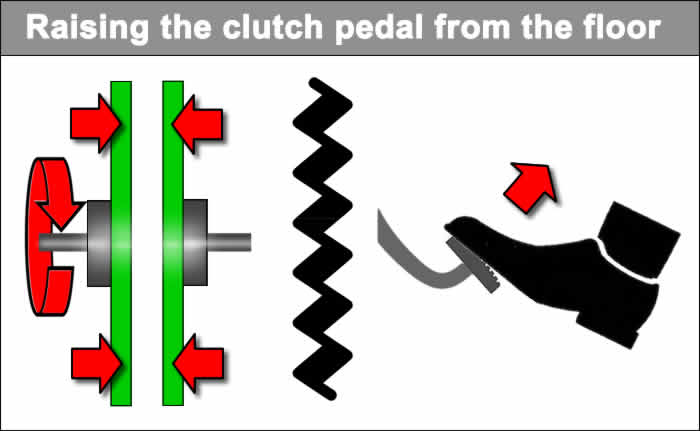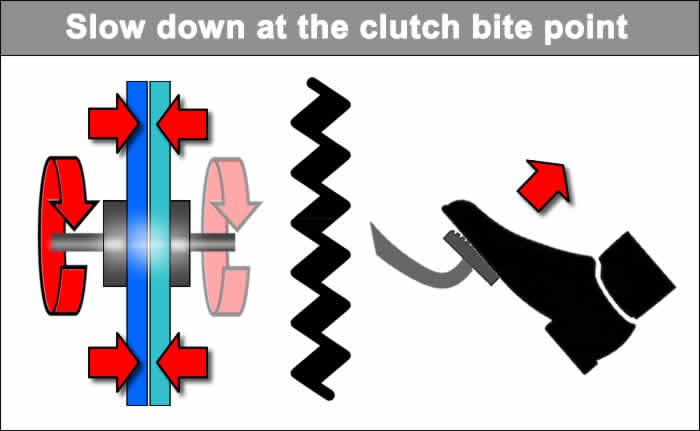What is the Clutch Bite Point
One of the more challenging aspects of learning to drive a manual car is raising the clutch pedal, particularly when moving off from a stationary position. The skill here is to raise the clutch pedal reasonably quickly, but without stalling the car and this is all about the clutch discs coming together.
By reading the learning the car clutch for beginners tutorial, you’ll understand that a car clutch, in its simplest form consists for two friction discs that separate when you press the clutch pedal and press together when you lift up the clutch pedal. The clutch bite point is the stage in which the two discs just begin to press together.
In this tutorial we’ll explain what happens to the clutch discs from when the pedal is pressed down, to when the pedal is lifted up and where the bite point fits in between the two.
Begin Raising the Clutch Pedal
Let’s begin with the clutch pedal fully pressed down to the floor and we’ll assume that we have 1st gear engaged with the handbrake off and the accelerator slightly pressed to increase engine power.

As we can see from the diagram, the clutch disc connected to the engine is constantly rotating at the speed of the engine. With the clutch pedal pushed down to the floor, the clutch discs are separated. Technically, from this point you can raise the clutch pedal as quickly as you wish until you reach the bite point. As you begin raising the clutch, give the engine a little power by slightly pressing the accelerator pedal.
The Clutch Bite Point
As we further raise the clutch, we now need to find the bite point. This diagram illustrates the clutch discs just starting to come together and this is called the bite point. The clutch disc connected to the engine is rotating constantly with the speed of the engine and the disc connected to the gearbox is rotating at a much slower speed.

If the friction discs come together too quickly, the difference in speed will stall the engine, so they need to meet gradually so that the slower disc connected to the gearbox has time to match the speed of the disc connected to the engine.
Whilst raising the clutch pedal from the floor, it’s at the bite point area that you must raise the pedal much slower. As the two discs begin to push together, the disc connected to the gearbox will begin to rotate faster and providing the car is in 1st gear and the handbrake is released, the car will begin to slowly move.
Releasing the Clutch Pedal
As you slowly raise the clutch pedal through the bite point, the car’s speed will increase. Cars are heavy and take a little time to get moving from a stationary position.

Due to the car now having momentum and the clutch discs almost rotating at the same speed, you can now fully release the clutch pedal as quickly as you wish. So, you can lift up the clutch quickly from the floor, slowly through the bite point and once the car has gained momentum, you can lift off for the remainder of the clutch pedal.
The slower you raise the clutch pedal though the bite point, the slower the car will move off. You can raise the clutch faster to allow the car to move off more quickly, but if you do it too fast, you risk stalling the engine.
To help reduce the risk of stalling the engine, you can increase the engine speed by gently pressing the accelerator. By providing a lot of engine power (more accelerator) and by lifting the clutch through the bite point area quickly, you’ll likely have wheelspin. It’s really all about practice and finding a balance between moving off smoothly and safely, but at a reasonably quick speed without spinning the wheels.
Now that you have a basic understanding of what happens to the clutch when you press down and lift up the clutch pedal, it should help with your ability of clutch control.
thanks, a lot now it makes sense cause when people explain it to me they just tell me you should lift up the clutch very slowly while gently accelerating, and I do exactly that but still the engine stalls. now that I’ve read your article I know that their advice is incomplete because while the “lifting the clutch slowly” part is indeed part of the solution, they don’t tell you when it should be implemented. This means I lift it up slowly before reaching the bite point and completely release it afterward which is the opposite of what should be done.
side note: this site is very helpful but it could be way better if it didn’t include ads that sexualize women.
thanks again.
Hi tajeddine,
Glad you found the site useful. Apologies for the ads. They’re implemented by Google. Not entirely sure why they’re putting such ads on a site about learning to drive.